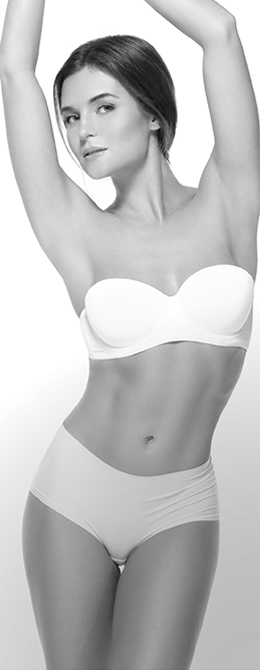
Body Contouring
Women or men who have lost significant weight are often left with drooping, sagging skin. No amount of exercise or diet will remove this excess skin, but surgery can remove the excess skin and provide a more attractive, toned contour.
Schedule a consultation
Who considers Body Contouring procedures?
Massive weight loss is like deflating a balloon. Skin becomes saggy, loose, and misshapen. Some pockets of fat remain. No amount of exercise or diet will remove this excess skin.
Men or women who see this excess skin often consider arm reduction or thigh lift, circumferential trunk lift, breast lift and augmentation, and face and neck lift. After massive weight loss, patients can see an improvement in blood pressure, diabetes, energy, breathing problems, and arthritis but they are reminded of their old, heavier body each time they look in the mirror and see sagging, draping skin.
Surgery can remove the excess skin and provide a more attractive, toned contour. Several procedures are often required to address all areas of concern and bring results as close to your goals as possible.
Most insurance does not cover these procedures. We are happy to help you check with your insurance carrier if you feel coverage may be available.
It is important to have realistic expectations about what the procedure can achieve.
Body Contouring Procedures
Circumferential Trunk Lift
Circumferential trunk lift, also called belt lipectomy, removes hanging, draping skin from the abdomen and back.
Arm Reduction
Arm reduction(brachioplasty) removes skin and fat (bat wings) to give a thinner, tighter arm contour. Incisions are modified if excess skin extends onto the chest.
Thigh Lift
Medial thigh lift is used to remove draping skin from the upper thighs. A thigh lift can be extended under the buttock or combined with abdominoplasty or circumferential trunk lift depending on where the excess skin is located.
Tummy Tuck
Designed to remove skin and fat from the lower abdomen and tighten the tummy muscles, a Tummy Tuck (Abdominoplasty) provides a flatter tummy contour, fewer stretch marks, and a better clothing fit. Incisions are placed to be as discreet as possible.
How is the procedure performed?
- Incisions vary depending on the areas of concern and degree of skin and excess fat.
- Muscles are tightened, and excess skin and fat is removed. Stitches and a drain are placed.
- Surgery is performed in either the office or hospital operating room depending on the procedure(s) performed and the extent of the surgery. Many patients go home the same day, but occasionally an overnight stay is required. General anesthesia is used and surgery takes 2 to 6 hours depending on the degree of contouring required, or combination of procedures performed.
- Some patients find that combining procedures optimizes recovery time, resulting in less time off work.
What is normal recovery?
Most patients experience moderate discomfort, which is relieved with prescription medications. Compressive, support garments are worn for 4 to 6 weeks. Patients are back to most activities within 2 to 3 weeks, depending on their job requirements. They are typically back to full, unrestricted activity within 4 to 6 weeks.
What are the expected results?
You can usually expect to have thinner arms, or thighs with removal of much of the excess skin. Patients who intend to lose additional weight should discuss this with Dr. Kennedy. As with all contouring procedures, realistic expectations are very important to ensure your expectations are in line with expected results.
Are there potential complications?
All surgery carries some risk. Body contouring after weight loss has become common and safe, but no surgery is without potential problems. These are generally minor, such as scarring, a change in sensation, unevenness or delayed fluid, and swelling. Rarely, more significant problems can occur.
Copy adapted from the joint ASPS and PSEF website.




